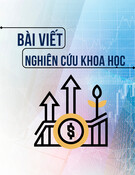
http://www.iaeme.com/IJM/index.asp 44 editor@iaeme.com
International Journal of Management (IJM)
Volume 9, Issue 5, September–Otober 2018, pp.44–54, Article ID: IJM_09_05_006
Available online at
http://www.iaeme.com/ijm/issues.asp?JType=IJM&VType=9&IType=5
Journal Impact Factor (2016): 8.1920 (Calculated by GISI) www.jifactor.com
ISSN Print: 0976-6502 and ISSN Online: 0976-6510
© IAEME Publication
GAMIFICATION IN CHANGE MANAGEMENT
CASE-STUDY CHANGCE-GAME
Matthias Kammer
Research Assistant, Doctoral Candidate
Research Institute for Corporate Management, Logistics and Production
TUM School of Management
Technical University of Munich, Germany
Sebastian Janocha
Master’s Degree Candidate
Technical University of Munich, Germany
Peter Witzgall
pi.con – Pulse of Innovation Consulting, Germany
ABSTRACT
Gamification is being used in more and more industries and in different business
areas. Today, there are applications in areas like customer management, marketing,
production, innovation management, sales and human resources.However,
gamification case studies with a focus on change management are rarely found in
those areas.
This study illustrates with a case study how gamification can be used in change
management processes. In addition, this study examines and discusses the benefits of
applying gamification as a method in change management, especially regarding
employee motivation. The gamified method that was used in the investigation is called
CHANGCE-Game and was applied at a customer of Pulse of Innovation Consulting in
June 2018.
Keyword head: Gamification, Change Management, Motivation, CHANGCE-Game.
Cite this Article: Matthias Kammer, Sebastian Janocha, Peter Witzgall Gamification
in Change Management – Case-Study Changce-Game, International Journal of
Management, 9 (5),2018, pp. 44–54.
http://www.iaeme.com/IJM/issues.asp?JType=IJM&VType=9&IType=4
1.
INTRODUCTION
In the dynamic business world, change is a constant companion. Many people see it as an
opportunity, some as a constant danger for their existence.Successfully managing change is
not trivial and the fear of existence of some companies is justified.Large companies such as
Kodak have already had to file for bankruptcy because change has not been properly managed

Gamification In Change Management – Case-Study Changce-Game
http://www.iaeme.com/IJM/index.asp 45 editor@iaeme.com
[1].To achieve sustainable success, companies must continually scrutinize their business
models, adapt them to the changing environment and update methods and processes because
of changing customer needs, new market innovations or new competitors. Although many
companies are facing these challenges, research shows that 70% of change efforts are
susceptible to failure [2]. Either because the reasons for change were not correctly identified,
the sources of resistance were not considered, or the success factors were not recognized
[3].One of the biggest uncertainty factors in the context of change are the employees. Since
they are most affected by the transformation and will ultimately execute the transition, their
motivation and contentment must be ensured throughout the change process [4].A new
approach to ensurethe needs of employees and decrease the failure of a change process could
be the use of gamification.
Parallel to the growing speed of transformation in business, the application of
gamification is increasing. Meanwhile, it has become an established method in numerous
areas ofcompanies, either implemented as a software tool or as a physical one, and it shows
positive effects such as higher motivation, performance, engagement, participation and other
essential attributes for organizations and their stakeholders [5]. Applications like Nike+ and
Miles&More use gamification in the context of their customer relationship management [6].
MyMarriot Hotel, Flip-Life and Wsabi are further examples of employer branding
applications from other companies [7]. Companies such as airBaltic introduced gamified
platforms to increase employee engagement and thereby keep satisfaction at a high level [8].
Originating in the media industry, gamification is spreading to the world of management [9].
In this study, we want to present a case study, in which gamification has been used in the
context of change management. Furthermore, we want to answer the following question:
“What are the concrete benefits of gamification in the context of change management,
especially for the employees and for the company?”. Therefore the “CHANGCE-Game” has
been applied in a company to induce a change process. The method has already been
introduced to literature by Witzgall et al. (2017). It was also analysed by Janocha et al.
(2018), focusing on the specific aspect of the incorporated role categorization [10,11].Now,
by interviewing the participants before-and-after the implementation, we want to identify the
noticeable effects of this gamified application in a business environment as well as derive and
recommend general benefits for the use of gamification in change management. Because this
is only one case study, the transferability is indeed limited, but trends that can be used for
further research can still be identified.
2. THEORETICAL BACKGROUND
2.1.Gamification
Gamification is defined as “the use of game design elements in non-game contexts” [9]. Game
design elements can be points, badges or achievements,leaderboards, levels, narratives,
performance graphs and avatars [5].Those elements are implemented in for example business
environments, so called “non-game contexts”, to get certain positive effects like a better
performance.In order to develop a gamification application Deterding, Hunicke,Zichermann
and Cunningham as well as Wildemann designed different approaches, which are context of
further research [9, 12, 13, 14].
Deterding et al. describes abstraction layers with five levels of game design elements [9].
The shared perception in research is that components can be distinguished by the degree of
possible perception by its user [11].The MDA framework by Hunicke et al. (2004) can be
described in three phases: Mechanics, Dynamics and Aesthetics [12]. Zichermann and
Cunningham (2011) also use this type of framework [13]. Wildemann (2017) combines

Matthias Kammer, Sebastian Janocha, Peter Witzgall
http://www.iaeme.com/IJM/index.asp 46 editor@iaeme.com
different models in order to successfully design a gamified concept and distinguishes between
six areas of design: player, behaviour, game mechanics, components, dynamics and aesthetics
[14].
Based on these frameworks, gamification is and has been applied in various contexts,
showing organizational and personal benefits [15]. With the assistance of enterprise,
gamification organizations can increase idea production by 30%, decrease production scrap
rate by 17% and heighten the number of applicants by 36% [14]. Gamified concepts tend
tospur on productive communication and high performance within organizations [5]. In
marketing, gamification promises to enhance customer engagement and loyalty, as shown by
the Nike+ fuelband, which increases its customers’ time commitment with the product and
service through the design of its competitive social network [6]. It has further proven
supportive in customer acquisition efforts [15]. Additional effective applications include
strengthening the impact of crowdsourcing initiatives, promoting the use of healthcare
systems and widening online communities [5].Apart from the named business applications,
gamification also shows utility for educational and training purposes. By embedding gamified
systems of interaction, feedback and comparison in an e-learning environment, success rates
of learning processes can be increased [16].
The positive impact on the motivation of its users seems to be responsible for the success
of these applications [5]. By addressing basic needs of autonomy, relatedness and
competence, intrinsic motivation can be increased to complete an activity [17]. Gamified
methods provide degrees of freedom for their users, create connections between the players
and reward desirable behaviour [15]. On the other hand, extrinsic motivation is also fuelled by
the incorporation of systems of incentive, which are represented by points, badges and other
types of rewards [18]. This increase of motivation consequently leads to lifted levels of
employee satisfaction and participation, as well as their higher performance and productivity
[15, 19].
2.2. Change Management
“Change management is the process of continually renewing an organization's direction,
structure, and capabilities to serve the ever-changing needs of external and internal
customers” [20]. Reasons for change can be triggered from outside or within the company.
They can originate from general market mechanisms (e.g. legal specifications) to individual
developments (e.g. technological trends). However, regardless of whether the source lies
outside or within, it can affect a company’s entire business model and operations, from
strategical repositioning to modifying daily work routines [21]. To sidestep possible failure
during a change process, many authors already identified sources of resistance, to respond
better to the risks of changes [3].
As common in business decisions, economic efficiency plays a major role during an
ongoing project. Rising costs and effects such as the sunk cost fallacy oppose new investment
decisions [20]. So, if the profitability of the project is no longer justified, the project will be
ended earlier than expected. The huge complexity of an ongoing project can also increase to
become such a big problem that the endeavour has to end, because, for example, suddenly the
analysing and implementing costs exceed the resulting benefit to the company. Furthermore,
organizational barriers could also lead to an early project termination. Finally, arguably the
biggest source of resistance, as they are most affected and trusted with the realization of the
change transition, are the employees of a company. Humans strive for a harmonic state of
psychological balance, are equipped with a lethargy for decision-making and are therefore
natural antagonists of change [21].

Gamification In Change Management – Case-Study Changce-Game
http://www.iaeme.com/IJM/index.asp 47 editor@iaeme.com
To master the sources of resistance, change management suggests different models like
those of Lewin (1946), Kotter (1995) and Krüger(2014). These models include steps like
creating a consciousness of the need for change, designing a vision of the desired status,
developing and realizing an implementation plan, as well as measuring and institutionalizing
the results [3, 24, 25]. They all point out that the employees play a key role in the entire
process and require special consideration. Therefore, in combination with the models, success
factors were derived that must be considered in a change process:
1. The motivation and engagement level of the employees must be ensured. The
individuals’ motivation requires the fulfilment of the basic needs for autonomy,
relatedness and competence [17].
2. Engaging employees at an early point transmits the feeling, that the change is not
forced and that autonomous decisions can be made purposefully and competently
[22].
3. A change process should be applied in a team to fulfil the need for social
integration and additionally draws upon the advantages of team dynamics [3, 22].
4. A heterogeneous, interdisciplinary group, that is adequate in size, benefits from the
diversity of skills and available knowledge [2, 20].
5. Lastly, efficient communication, competent leadership and the use of consultation
services can prove beneficial when undergoing a change within a company [3, 20,
21, 22]
6. Gamified methods have the potential to consider allofthese success factorsand
therefore prove to be a promising approach, especially to solve motivation and
engagement risks in the context of the change process.
3. METHODOLOGY
3.1.Research Design
Although gamification is still a relatively young study field, it alreadyhas an excellent
reputation in scientific research [26]. This study wants to expand the existing literature with a
case study, which shows the positive effects of applying gamification as a method in change
management, especially regarding employee motivation. As this is only one case study,
general validity and transferability to other case studies are limited, but trends can still be
identified that can be used for further research. In the context of analysing the gamified
method "CHANGCE-Game" in an industry setting, a qualitative research design was applied
to get a detailed insight of the real-world application and the benefits. Furthermore, to identify
the potentials of the CHANGCE-Game and trends of gamification in general in the context of
change management the analysis was twofold. In the first part the structure and the gamified
components of the method were scrutinized and compared with the general gamification
effects of the literature. Then participants of a workshop were interviewed beforeandafter the
workshop to identify the concrete practical benefits.
The practical part of this research encompasses the execution of the CHANGCE-Game at
a hotel and restaurant business in Southern Germany in June 2018, as well as eleven semi-
structured, personal interviews with participants before and after the workshop. The open
questions prior to the game pertained to general information about the participants and their
functions in the organization, employee motivation and change processes, and general
perception of workshop methods. The interviews after the execution of the workshop
concerned the specific elements of the gamified method and perceived benefits of
gamification in change management. Close collaboration with Pulse of Innovation Consulting
and countless sources of documented information, such as workshop protocols, company

Matthias Kammer, Sebastian Janocha, Peter Witzgall
http://www.iaeme.com/IJM/index.asp 48 editor@iaeme.com
websites and the creator’s manuscript, have been used to describe and analyse the approach.
Using the MAXQDA software the results of the interviews were coded and analysed. By
triangulating different data sources, the validity and objectivity of our findings have been
increased, allowing to derive trends and a sounder generalization of the theory on
gamification in change management [27].
3.2. Research Context Case-Study CHANGCE-Game
Focal point of this case-study are the benefits of the gamified method called the CHANGCE-
Game, which represents a gamified workshop tool within the concept of CHANGCE-thinking
of Pulse of Innovation Consulting. It has been subject to previous research, having first been
generally introduced [10] and one of its main components of roleplay analysed [11]. The
general aim of the CHANGCE-thinking mindset is to combine the systematic search for and
implementation of chances, while establishing a culture of chance orientation rather than risk
aversion in companies [10]. We define chances as opportunities for enterprises to improve in
a certain dimension (e.g. increasing work efficiency through novel communication
technologies) [11]. CHANGCE-thinking acts as a guide and offers valuable tools throughout
a change process, one of which portrays the starting point in the shape of a gamified
workshop, seeking to foster enthusiasm and a lasting drive for change. The CHANGCE-Game
allows players to broaden their horizon by exploring eight chance-rooms within their
organization, while portraying eight different roles. By using the playful drive of people, a
strategic groundwork for future endeavours can be created [14]. The incorporated gamified
elements inspire creativity among employees, allowing a thorough examination of their
company’s chances and potentials [11].
The CHANGCE-Game consists of three playing phases: preparation, game play and
debriefing [10]. Firstly, each player selects a role, which they would like to play with during
the workshop. Eight playing pieces represent eight different role types and correspond to eight
chance-rooms, which are a symbolic compartmentalization of the organization (see Table 1)
[10].
Table 1 CHANGCE-thinking chance-rooms and their respective roles [11]
Chance-Room Role Type Description of Role
Spirit Spirit creator, reformer
initiative, intuitive, lively
Opportunities Space leader, manager
defining, aware, fact oriented, controlling
Capabilities Skill worker
process and result oriented, constant
Collaboration Collaboration team player, connector
motivating, open, communicative, cooperative
Shareholders Shareholder business man, director
goal oriented, motivating, visionary, dominant
Flow Flow
bridge builder
caring, calm, supportive, balanced, cautious
Customers Customer buyer, user
confident, demanding, selective, critical
Environment Social Minder observer, protector
social, just, preserving, sensible

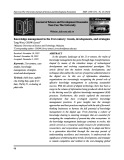
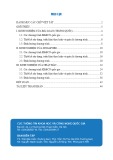





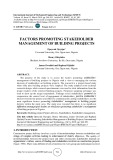
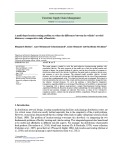

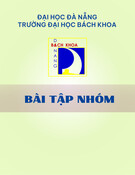


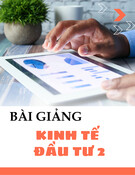

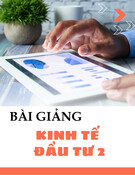
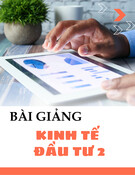

![20 câu hỏi Quản lý dự án phần mềm có đáp án [mới nhất]](https://cdn.tailieu.vn/images/document/thumbnail/2025/20251003/hieu2004haha@gmail.com/135x160/78791759734259.jpg)
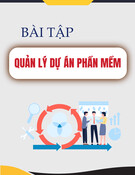

![Tài liệu Quản lý dự án: Kiến thức nền tảng toàn diện [chuẩn SEO]](https://cdn.tailieu.vn/images/document/thumbnail/2025/20250910/kimphuong1001/135x160/92631757496585.jpg)


